Results
-
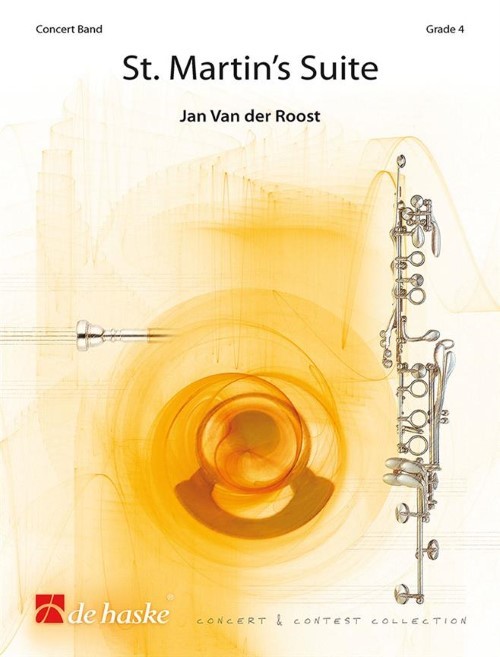 £149.99
£149.99St. Martin's Suite (Concert Band - Score and Parts) - Van der Roost, Jan
This suite was composed by Jan Van der Roost on the occasion of the 110th anniversary of the 'Koninklijke Sint Martinusfanfare' (Royal Saint Martinus Fanfare Band) from Halle (Belgium). The composer was required to create a suite in three movements based on three images associated with the 'Sint Martinusfanfare' from the small town of Halle in the province of Brabant. The first movement (Andante Pomposo) describes Martin, a soldier in the Roman army. In Andante Moderato we see the image of Martin, who become a Christian and chooses to devote his life to God. In this movement, the composer was inspired by the Brabantine gothic art of the Sint Martinus Basilica in Halle. The contrast between the dark Basilica and the statue of Our Lady between the soaring pillars will vividly come to life for audiences of this descriptive piece. The final movement, Allegro Molto Vivace', could have been an image for a frivolous peasant in the Halle carnival. In a triptych about St. Martin it is more fitting to refer to it as an apotheosis, the crown on the pastoral work of Martin, Bishop of Tours, Patron Saint of the Fanfare Band and the Basilica of Halle.Duration: 13:30
Estimated dispatch 7-14 working days
-
 £149.99
£149.99St. Martin's Suite - Jan Van der Roost
This suite was composed by Jan Van der Roost on the occasion of the 110th anniversary of the 'Koninklijke Sint Martinusfanfare' (Royal Saint Martinus Fanfare Band) from Halle (Belgium). The composer was required to create a suite in three movements based on three images associated with the 'Sint Martinusfanfare' from the small town of Halle in the province of Brabant. The first movement (Andante Pomposo) describes Martin, a soldier in the Roman army. In Andante Moderato we see the image of Martin, who become a Christian and chooses to devote his life to God. In this movement, the composer was inspired by the Brabantine gothic art of the Sint Martinus Basilica in Halle. Thecontrast between the dark Basilica and the statue of Our Lady between the soaring pillars will vividly come to life for audiences of this descriptive piece. The final movement, Allegro Molto Vivace', could have been an image for a frivolous peasant in the Halle carnival. In a triptych about St. Martin it is more fitting to refer to it as an apotheosis, the crown on the pastoral work of Martin, Bishop of Tours, Patron Saint of the Fanfare Band and the Basilica of Halle.
Estimated dispatch 7-14 working days
-
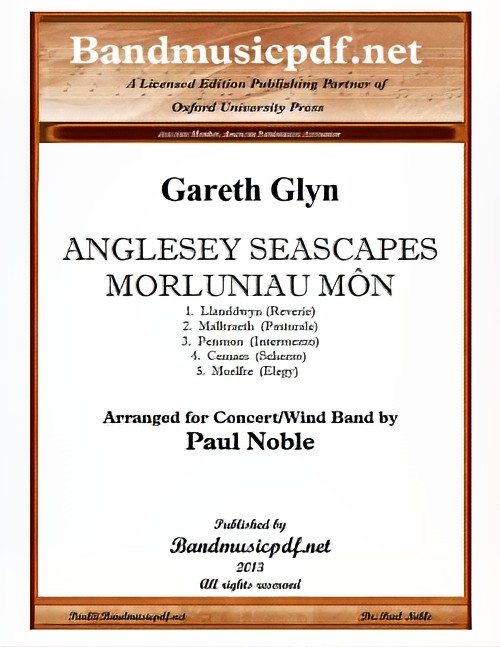 £240.00
£240.00Anglesey Seascapes (Concert Band - Score and Parts) - Glyn, Gareth - Noble, Paul
Gareth Glyn lives on the island of Anglesey, where the encircling sea has always been indivisible from the mythology, history and everyday life and work of its people. This cycle of short miniatures, in a light music vein, seeks to represent various aspects of the sea as seen from five vantagepoints around the coast of Anglesey. The whole work is bound together by recurring musical motifs which change their character according to the prevailing mood. 1. Llanddwyn (Reverie): Island of the Welsh patron saint of lovers, Dwynwen, whose marriage to Maelon was never to be, and who dedicated her life to God. 2. Malltraeth (Pastorale): A brisk walk along Cob Malltraeth, a high dyke built to keep out the sea. 3. Penmon (Intermezzo): From a vantage point by the sacred priory of St Seiriol, old sailing ships and modern yachts can be seen scudding by in Regatta week. 4. Cemaes (Scherzo): The bustle of children's play and donkey-rides on the beach in midsummer. 5. Moelfre (Elegy): In remembrance of innumerable souls lost in shipwrecks off this coast, including the Royal Charter with its loss of 452 lives.
Estimated dispatch 7-14 working days
-
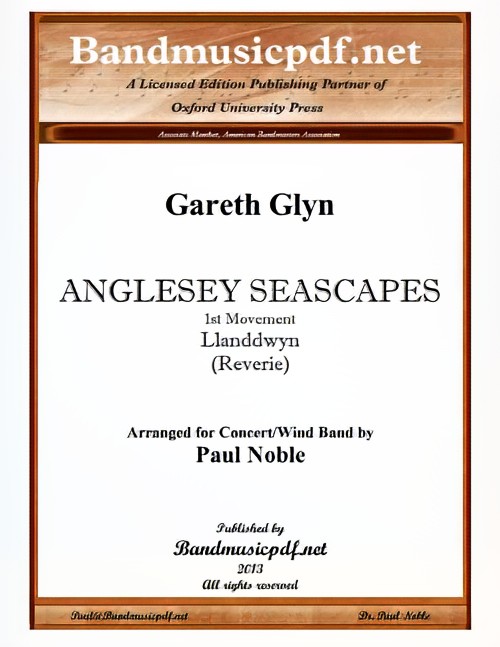 £65.00
£65.00Anglesey Seascapes, 1st Movement (Concert Band - Score and Parts) - Glyn, Gareth - Noble, Paul
Gareth Glyn lives on the island of Anglesey, where the encircling sea has always been indivisible from the mythology, history and everyday life and work of its people. This cycle of short miniatures, in a light music vein, seeks to represent various aspects of the sea as seen from five vantagepoints around the coast of Anglesey. The whole work is bound together by recurring musical motifs which change their character according to the prevailing mood. 1. Llanddwyn (Reverie): Island of the Welsh patron saint of lovers, Dwynwen, whose marriage to Maelon was never to be, and who dedicated her life to God. 2. Malltraeth (Pastorale): A brisk walk along Cob Malltraeth, a high dyke built to keep out the sea. 3. Penmon (Intermezzo): From a vantage point by the sacred priory of St Seiriol, old sailing ships and modern yachts can be seen scudding by in Regatta week. 4. Cemaes (Scherzo): The bustle of children's play and donkey-rides on the beach in midsummer. 5. Moelfre (Elegy): In remembrance of innumerable souls lost in shipwrecks off this coast, including the Royal Charter with its loss of 452 lives.
Estimated dispatch 7-14 working days
-
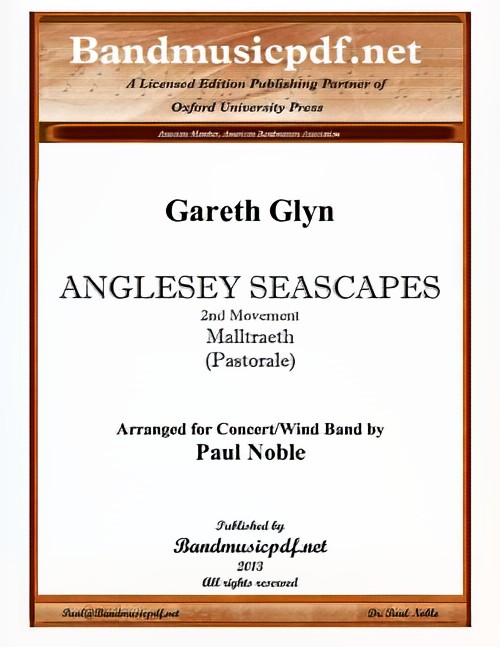 £65.00
£65.00Anglesey Seascapes, 2nd Movement (Concert Band - Score and Parts) - Glyn, Gareth - Noble, Paul
Gareth Glyn lives on the island of Anglesey, where the encircling sea has always been indivisible from the mythology, history and everyday life and work of its people. This cycle of short miniatures, in a light music vein, seeks to represent various aspects of the sea as seen from five vantagepoints around the coast of Anglesey. The whole work is bound together by recurring musical motifs which change their character according to the prevailing mood. 1. Llanddwyn (Reverie): Island of the Welsh patron saint of lovers, Dwynwen, whose marriage to Maelon was never to be, and who dedicated her life to God. 2. Malltraeth (Pastorale): A brisk walk along Cob Malltraeth, a high dyke built to keep out the sea. 3. Penmon (Intermezzo): From a vantage point by the sacred priory of St Seiriol, old sailing ships and modern yachts can be seen scudding by in Regatta week. 4. Cemaes (Scherzo): The bustle of children's play and donkey-rides on the beach in midsummer. 5. Moelfre (Elegy): In remembrance of innumerable souls lost in shipwrecks off this coast, including the Royal Charter with its loss of 452 lives.
Estimated dispatch 7-14 working days
-
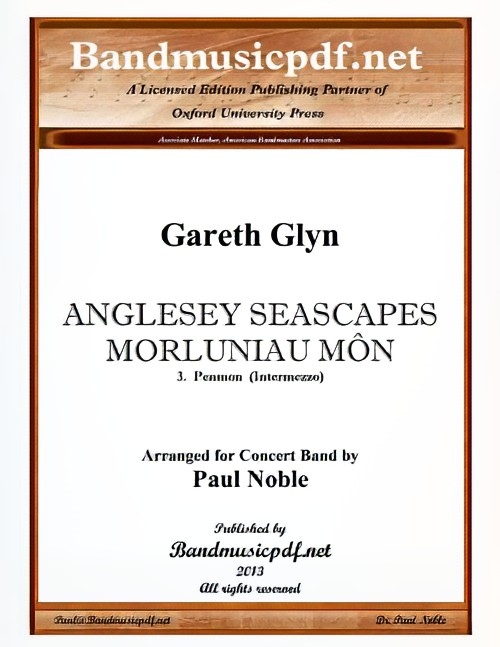 £65.00
£65.00Anglesey Seascapes, 3rd Movement (Concert Band - Score and Parts) - Glyn, Gareth - Noble, Paul
Gareth Glyn lives on the island of Anglesey, where the encircling sea has always been indivisible from the mythology, history and everyday life and work of its people. This cycle of short miniatures, in a light music vein, seeks to represent various aspects of the sea as seen from five vantagepoints around the coast of Anglesey. The whole work is bound together by recurring musical motifs which change their character according to the prevailing mood. 1. Llanddwyn (Reverie): Island of the Welsh patron saint of lovers, Dwynwen, whose marriage to Maelon was never to be, and who dedicated her life to God. 2. Malltraeth (Pastorale): A brisk walk along Cob Malltraeth, a high dyke built to keep out the sea. 3. Penmon (Intermezzo): From a vantage point by the sacred priory of St Seiriol, old sailing ships and modern yachts can be seen scudding by in Regatta week. 4. Cemaes (Scherzo): The bustle of children's play and donkey-rides on the beach in midsummer. 5. Moelfre (Elegy): In remembrance of innumerable souls lost in shipwrecks off this coast, including the Royal Charter with its loss of 452 lives.
Estimated dispatch 7-14 working days
-
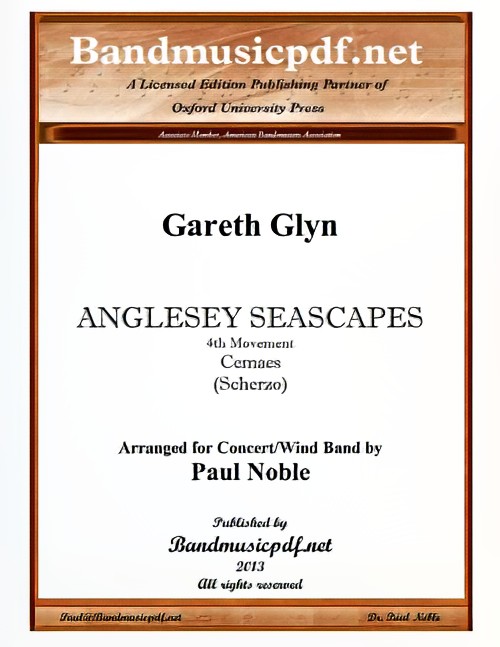 £65.00
£65.00Anglesey Seascapes, 4th Movement (Concert Band - Score and Parts) - Glyn, Gareth - Noble, Paul
Gareth Glyn lives on the island of Anglesey, where the encircling sea has always been indivisible from the mythology, history and everyday life and work of its people. This cycle of short miniatures, in a light music vein, seeks to represent various aspects of the sea as seen from five vantagepoints around the coast of Anglesey. The whole work is bound together by recurring musical motifs which change their character according to the prevailing mood. 1. Llanddwyn (Reverie): Island of the Welsh patron saint of lovers, Dwynwen, whose marriage to Maelon was never to be, and who dedicated her life to God. 2. Malltraeth (Pastorale): A brisk walk along Cob Malltraeth, a high dyke built to keep out the sea. 3. Penmon (Intermezzo): From a vantage point by the sacred priory of St Seiriol, old sailing ships and modern yachts can be seen scudding by in Regatta week. 4. Cemaes (Scherzo): The bustle of children's play and donkey-rides on the beach in midsummer. 5. Moelfre (Elegy): In remembrance of innumerable souls lost in shipwrecks off this coast, including the Royal Charter with its loss of 452 lives.
Estimated dispatch 7-14 working days
-
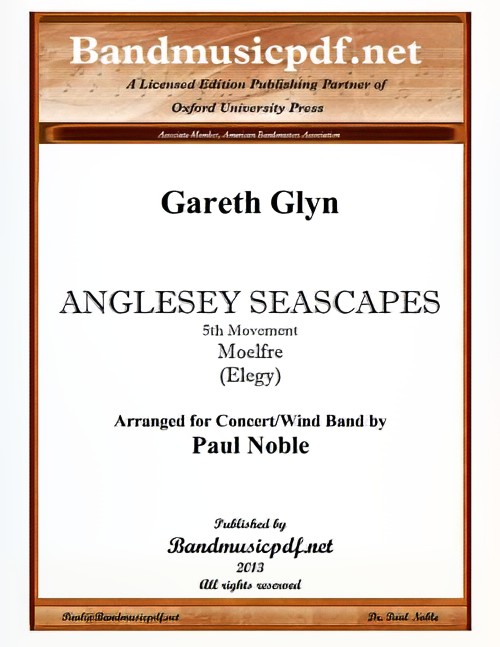 £65.00
£65.00Anglesey Seascapes, 5th Movement (Concert Band - Score and Parts) - Glyn, Gareth - Noble, Paul
Gareth Glyn lives on the island of Anglesey, where the encircling sea has always been indivisible from the mythology, history and everyday life and work of its people. This cycle of short miniatures, in a light music vein, seeks to represent various aspects of the sea as seen from five vantagepoints around the coast of Anglesey. The whole work is bound together by recurring musical motifs which change their character according to the prevailing mood. 1. Llanddwyn (Reverie): Island of the Welsh patron saint of lovers, Dwynwen, whose marriage to Maelon was never to be, and who dedicated her life to God. 2. Malltraeth (Pastorale): A brisk walk along Cob Malltraeth, a high dyke built to keep out the sea. 3. Penmon (Intermezzo): From a vantage point by the sacred priory of St Seiriol, old sailing ships and modern yachts can be seen scudding by in Regatta week. 4. Cemaes (Scherzo): The bustle of children's play and donkey-rides on the beach in midsummer. 5. Moelfre (Elegy): In remembrance of innumerable souls lost in shipwrecks off this coast, including the Royal Charter with its loss of 452 lives.
Estimated dispatch 7-14 working days
-
 £118.99
£118.99Asteroid Wind Band Set (Score & Parts)
Asteroids and comets have played an important role throughout the history of life on earth. It is quite probable that the dinosaurs have been exterminated by an asteroid's impact in the Gulf of Mexico. Huge tidal waves and fire storms wiped out all life. This is the year 2067 according to the Christian calendar. A collision has just taken place in the asteroid belt between Mars and Jupiter and caused an asteroid to enter the earth's power of gravitation. It is instoppably approaching the blue planet. As its peoples have been fighting each other continuously, they missed the building of a global defence system against dangers coming from space. A scanner records the asteroid and immediately sends a message to the President of the Anglo-American Union. The probability that the asteroid will hit the earth is judged 50% by the experts. Plans are made to shoot the celestial body with rockets live with hydrogen bombs or laser guns in order to throw it off its track, but they fail. The asteroid's size seems to threaten the existence of mankind. Those in the know stare at the night sky in bewilderment. But for the time being, there is still peace on earth.... 0:07:45
Estimated dispatch 7-14 working days
-
 £332.99
£332.99Cantica de Sancto Benedicto Wind Band Set (Score & Parts)
Cantica de Sancto Benedicto is a three-movement work for mixed choir, soprano solo, concert band and organ ad libitum - on Latin lyrics that relate to the life of Saint Benedict. It was commissioned by the city of Norcia in Italy, where Benedict was born. The holy Benedict (480-547) is considered the founder of monastic life within the Roman Catholic Church. His enormous influence is especially owing to his monastic rule, the Regula Benedicti.Jacob de Haan has named the movements of Cantica de Sancto Benedicto after the Holy Trinity: the Father (Gloria Patri), the Son (Gloria Filio) and the Holy Spirit (Gloria Spiritui Sancto). The lyrics of thehymn Gemma Caelestis, (which, like the other texts, were originally used in Gregorian chant) are voiced by the choir. To this purpose, Jacob de Haan composed new, choral-like, homophone music. The sequence Laeta Quies is rendered by the soprano; the verses (divided over the three movements) are alternated with those of Gemma Caelestis. The work closes with an impressive grand finale, in which texts are used from the proprium of the mass in honor of the saint's day of the holy Benedict (11 July). Notes to the conductor: For this cantata, there are various possibilities for the performance. The first involves a performance in which the choir and soprano parts are only accompanied by organ. Such a performance has several advantages: since the band never sounds together with the choir and the soprano, no balance problems occur, and even a performance with a large concert band and a small cantata choir is conceivable. A special layout is also possible - with which you can set up a three-dimensional performance in a church. For example, the choir can sing in the chancel, accompanied by the choir organ; the soprano can stand on the gallery, accompanied by the main organ; and the band can be seated in another part of the church. The choir could also sing from a gallery. With layouts like this, working with two conductors is advisable. Choral parts available separately. 0:28:30
Estimated dispatch 7-14 working days
